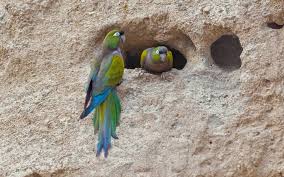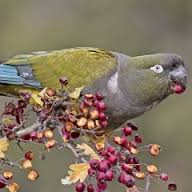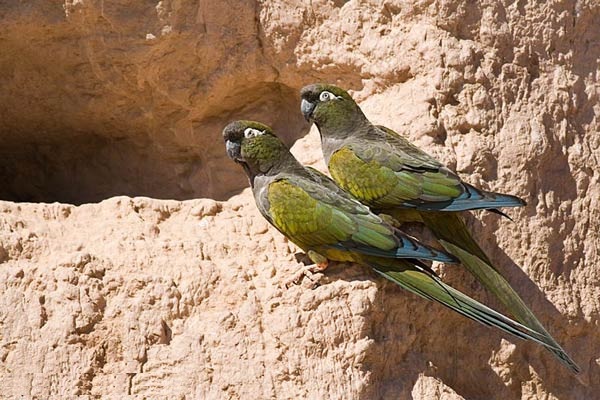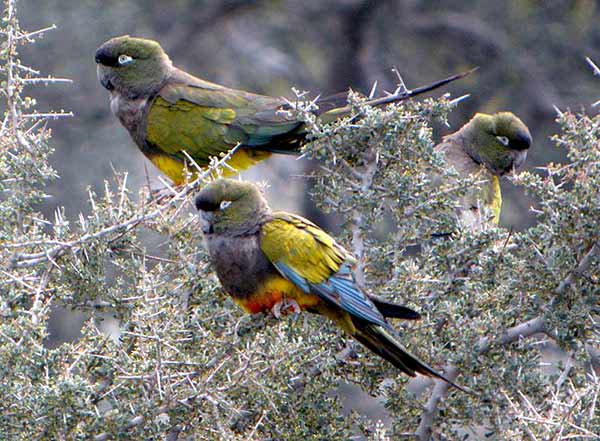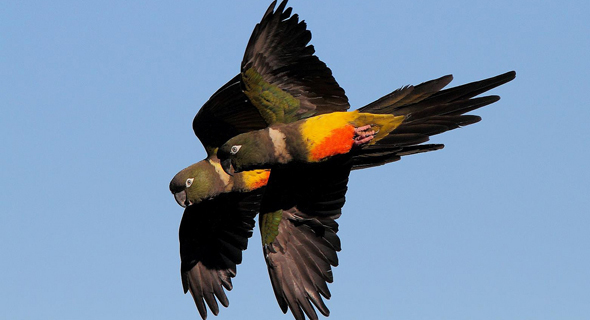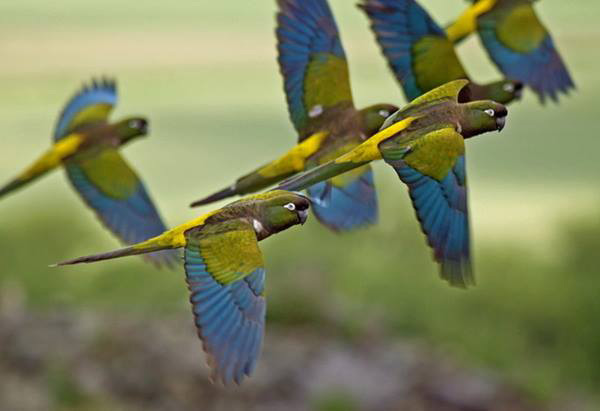The burrowing parrot is a bird species in the parrot family. It belongs to the smaller long-tailed Arinae
(macaws and conures). It is also known as the Patagonian conure and some authorities call it the burrowing
parakeet. The burrowing parrot belongs to the monotypic genus Cyanoliseus, but the species is not monotypic,
having several subspecies.
It is mainly found in Argentina. A very much reduced population still survives in Chile, and migration of
some Argentine populations to Uruguay has been reported for the winter. Sometimes, strong westerly winds
bring some individuals to the Falkland Islands.
Its natural habitat is the arid bush steppe community known as the Monte Desert.
The burrowing parrot has a monogamous mating system with very strong biparental care. Genetic testing has
recently shown that this species is one of a few animals that is genetically monogamous in a socially
monogamous mating system. Nest parasitism is not known to occur in this species. The Patagonian Conure has
eyelashes, a distinctive feature among birds.
Description
The Burrowing Parakeet or Patagonian Conure was formerly common in Argentina. Today, these beautiful birds
are extinct in some areas, due to persecution as crop pest, habitat loss and pet trade.
Adult has dull olive-brown head, neck, back and lower breast. The long tail is olive-green and conspicuously
graduated. The upperwing shows greenish olive coverts, olive secondaries and bluish primaries.
The lower back, upper and undertail coverts, upper belly and flanks are yellow. Thighs and centre of belly
are red-orange. Throat and upper breast are greyish-brown. We can see an indistinct patch on breast sides.
On the dull olive-brown head, the short hooked bill is grey. Eyes are whitish to pale yellow, surrounded by
conspicuous bare white eye-ring. Legs and feet are pale pinkish.
Both sexes are similar.
The juvenile resembles adults with horn-coloured patch on the bill.
Diet
The Burrowing Parakeet feeds mainly on seeds taken from the ground and from the vegetation, but it also
consumes fruits and berries.
This species also takes grain crops, and is considered as crop pest, involving persecution from farmers.
Habitat
The Burrowing Parakeet usually frequents open country near streams, arid lowland, montane grassy shrubland,
open dry savannah with trees, thorny scrub and cacti with sandy soil, up to 2000 metres of elevation.
This bird can be seen in pastures and cultivated areas, and also in urban areas where groups roost on wires.
Range
The Burrowing Parakeet is a South American species, found in Argentina, with a small isolated population in
C Chile.
Behavior
The Burrowing Parakeet feeds on seeds taken from the ground and from the vegetation (in winter). It also
consumes berries and fruits from several plant species.
This parakeet very conspicuous and noisy is also gregarious. They sleep in communal roosts in trees, wires
or in their nesting burrows where they gather in large flocks. Before sunrise, they call and flutter around
the roost and the departure occurs at dawn, at the first light. The flock flies high in long irregular
formation.
By day, the birds perform low flight, pausing briefly on low branches before to reach the ground to feed.
The olive-brown plumage provides them good camouflage while foraging.
The Burrowing Parakeet is seasonal migrant in southern parts of the range. Populations of Central Chile
perform altitudinal movements.
In other regions, the species is resident, with only local wandering according to the food resources.
Reproduction
Breeding season occurs between September and February.
The Burrowing Parakeet nests in colonies in cliff-faces. The nest is a burrow excavated in sandstone or earth
cliff, often along river or sea and at considerable height.
This species is monogamous with long pair-bonds. They excavate the burrows which often are interconnecting.
The established pairs usually reuse the same burrow every year, while the new pairs must excavate a new one.
There is a tunnel of about 80-250 centimetres long; often in a zigzag, opening into the nest-chamber where
the eggs are laid and the chicks raised.
Female lays 2-4 eggs and incubates alone during about 24 days. She is fed by the male during this period.
The nesting period lasts two months before the young leave the nest. They still depend on parents for several
months more.
BehFlightavior
The Burrowing Parakeet has direct flight, performing rhythmic shallow wing beats.




